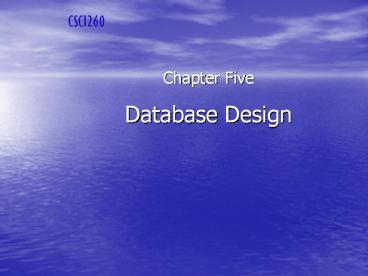Database Design - PowerPoint PPT Presentation
Title:
Database Design
Description:
CSCI260 Chapter Five Database Design – PowerPoint PPT presentation
Number of Views:61
Avg rating:3.0/5.0
Title: Database Design
1
Database Design
CSCI260
- Chapter Five
2
Chapter Objectives
- Learn how to transform E-R data models into
relational designs - Practice the normalization process from Chapter 2
- Understand the need for denormalization
- Learn how to represent weak entities with the
relational model - Know how to represent 11, 1N, and NM binary
relationships
3
Chapter Objectives (continued)
- Know how to represent 11, 1N, and NM recursive
relationships - Learn SQL statements for creating joins over
binary and recursive relationships - Understand the nature and background of
normalization
4
Representing Entities with the Relational Model
- Create a relation for each entity
- Give it same name as Entity
- Create column for each attribute
- Set primary key as the identifier
- The relation is then analyzed using the
normalization rules - As normalization issues arise, the initial
relation design may need to change
5
Representing the ITEM entity
- ITEM (Itemnumber, Description, Cost, ListPrice,
QuantityOnHand)
6
Representing the CUSTOMER entity
- CUSTOMER (CustomerNumber, CustomerName, Address,
City, State, Zip, Contact, PhoneNumber)
7
Representing the CUSTOMER entity
- Normalization process check for functional
dependencies - Zip -gt (City, State)
- Contact -gt PhoneNumber
8
Representing the CUSTOMER entity
- CUSTOMER (CustomerNumber, CustomerName, Address,
Zip, Contact) - ZIP (Zip, City, State)
- CONTACT (Contact, PhoneNumber)
- Zip in CUSTOMER must exist in Zip in ZIP
- Contact in CUSTOMER must exist in Contact in
CONTACT
9
Anomalies
- Relations that are not normalized will experience
issues known as anomalies - Insertion anomaly
- Difficulties inserting data into a relation
- Modification anomaly
- Difficulties modifying data into a relation
- Deletion anomaly
- Difficulties deleting data from a relation
10
Solving Anomalies
- Most anomalies are solved by breaking an existing
relation into two or more relations through a
process known as normalization
11
Definition Review
- Functional dependency
- The relationship (within the relation) that
describes how the value of a one attribute may be
used to find the value of another attribute - Determinant
- The attribute that can be used to find the value
of another attribute in the relation - The right-hand side of a functional dependency
12
Definition Review
- Candidate key
- The value of a candidate key can be used to find
the value of every other attribute in the
relation - A simple candidate key consists of only one
attribute - A composite candidate key consists of more than
one attribute
13
Normal Forms
- There are many defined normal forms
- First Normal Form (1NF)
- Second Normal Form (2NF)
- Third Normal Form (3NF)
- Boyce-Codd Normal Form (BCNF)
- Fourth Normal Form (4NF)
- Fifth Normal Form (5NF)
- Domain/Key Normal Form (DK/NF)
14
Normalization
- For our purposes, a relation is considered
normalized when - Every determinant is a candidate key
- Technically, this is Boyce-Codd Normal Form
(BCNF)
15
Denormalization
- Normalizing relations (or breaking them apart
into many component relations) may significantly
increase the complexity of the data structure - The question is one of balance
- Trading complexity for anomalies
- There are situations where denormalized relations
are preferred
16
Denormalization Example
- Breaking Zip into own table makes CUSTOMER
normalized - However it makes it more difficult to use
- People are used to entering City, State and Zip
together - DBMS has to read two tables just to get
customers address
17
Denormalization Issues
- Inserts with zip as separate table, cant
insert address without having entry in Zip table.
Thats ok we want to just enter the City,
State, Zip with the rest of the address. - Updates how often does a city change its Zip
code?
18
SALES-COMMISSION example
- 1 Construct relation with all the entitys
attributes as columns - 2 Relation is Normalized
- 3 If Normalization is too pure, Relation is
denormalized
19
SALES-COMMISSION example
20
SALES-COMMISSION example
- SALES-COMMISSION( SalespersonNumber,
SalespersonName, Phone, CheckNumber, CheckDate,
CommissionPeriod, TotalCommissionSales,
CommissionAmount, BudgetCategory)
21
SALES-COMMISSION example
- Functional Dependencies
- SalespersonNumber -gt (SalespersonName, Phone,
BudgetCategory) - (SalespersonNumber, ComissionPeriod) -gt
(TotalCommissionSales, CommissionAmount) - Extract attributes of the functional dependencies
from original table and make the determinants the
keys of new table. - Leave copy of determinants in original table as
foreign key.
22
SALES-COMMISSION example
- SALES-COMMISSION (SalesPersonNumber, CheckNumber,
CheckDate, CommissionPeriod) - SALESPERSON (SalespersonNumber, SalespersonName,
Phone) - SALES (SalespersonNumber, CommissionPeriod,
TotalCommissionSales, CommissionAmount)
23
SALES-COMMISSION example
- Referential Integrity Contstraints
- SalespersonNumber in SALES-COMMISSION must exist
in SalespersonNumber in SALESPERSON - (SalespersonNumber, CommissionPeriod) in
SALES-COMMISSION must exist in (SalespersonNumber,
CommissionPeriod) in SALES
24
SALES-COMMISSION example
- Denormalization possibilities
- Any reason to not create SALESPERSON or SALES
relations?
25
Weak Entities
- For an ID-dependent weak entity, the key of the
parent becomes part of the key of the weak entity
26
- (b) LineNumber not complete key needs to have
InvoiceNumber since it is ID-Dependant - (c)






























